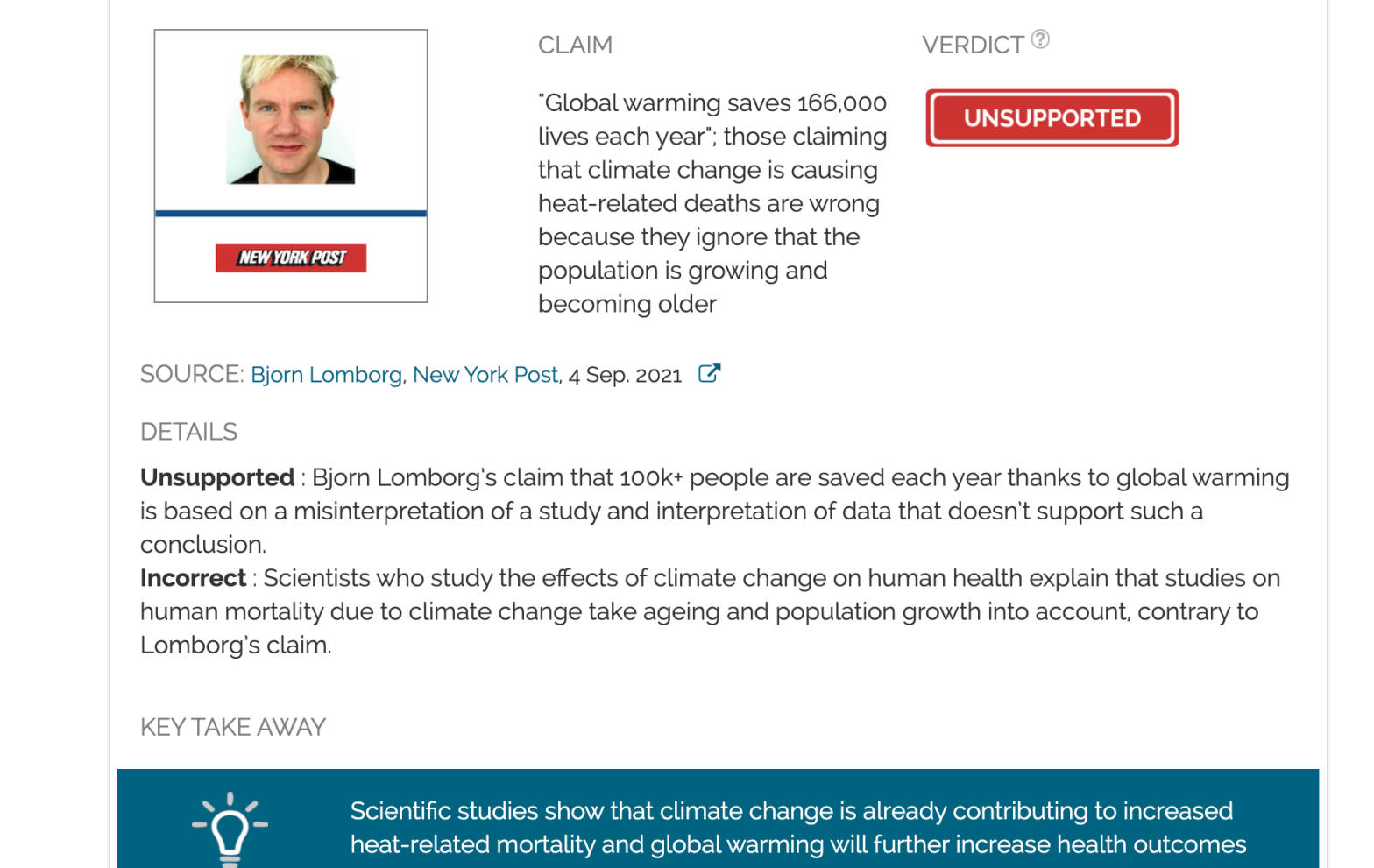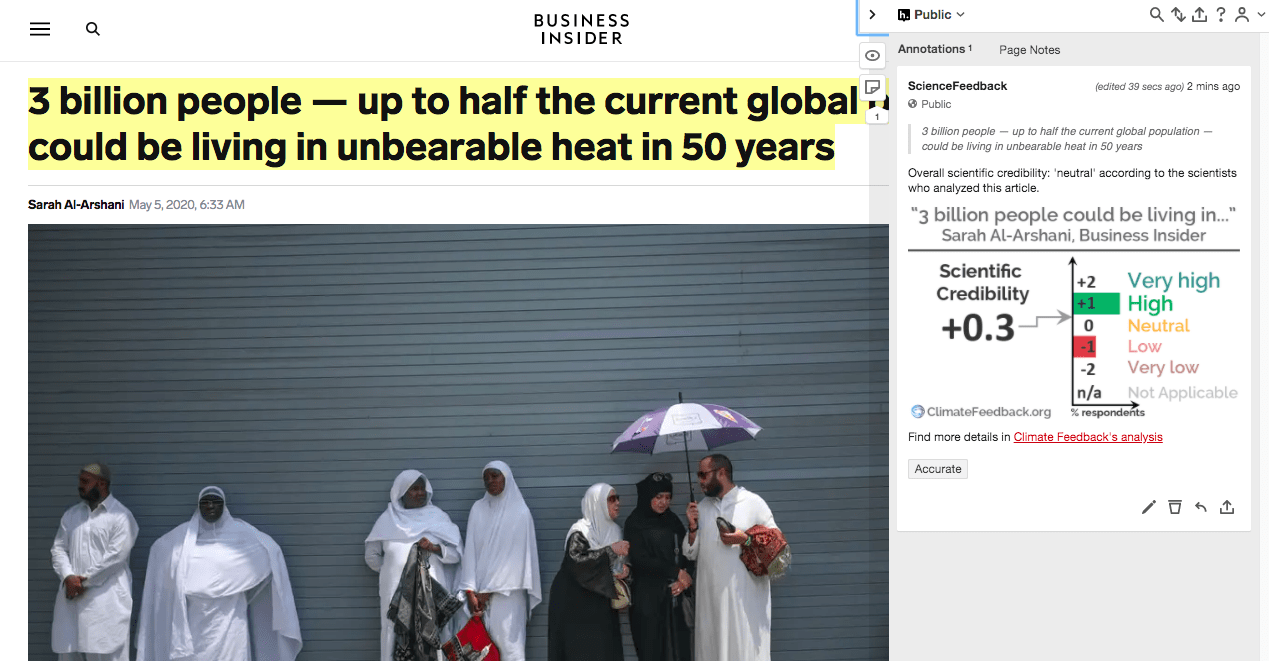- Climate
Global warming contributes to increased heat-related mortality, contrary to Bjorn Lomborg’s unsupported claims that climate change is saving hundreds of thousands of lives each year
Key takeaway
Scientific studies show that climate change is already contributing to increased heat-related mortality and global warming will further increase health outcomes related to heat stress. Reports that take into account the ensemble of scientific publications show that climate change is overall having negative consequences for human societies and ecosystems, contrary to what cherry-picking can lead some to believe.
Reviewed content

Claim:
"Global warming saves 166,000 lives each year"; those claiming that climate change is causing heat-related deaths are wrong because they ignore that the population is growing and becoming older
Verdict detail
Unsupported : Bjorn Lomborg’s claim that 100k+ people are saved each year thanks to global warming is based on a misinterpretation of a study and interpretation of data that doesn’t support such a conclusion.
Incorrect : Scientists who study the effects of climate change on human health explain that studies on human mortality due to climate change take ageing and population growth into account, contrary to Lomborg’s claim.
Full Claim
"Global warming saves 166,000 lives each year"; those claiming that climate change is causing heat-related deaths are wrong because they ignore that the population is growing and becoming older
Summary
UPDATE 2021-09-22: Following the publication of our review, Bjorn Lomborg published a series of Facebook posts and tweets insisting that his claim that global warming is saving 100k+ lives per year was correct and supported by the Zhao et al. paper published in The Lancet. Professor Yuming Guo, the second author of the paper, commented on behalf of the research consortium that led the study and confirmed to Climate Feedback that Lomborg’s interpretation of their research is incorrect: the study did not assess whether the changes in cold and heat-related deaths over the past 20 years can be attributed to temperature changes or to other factors. (Scroll down to read Guo’s entire comment.)
In the posts, Lomborg also claimed that this review misquoted him and that he never said that heat-related deaths have decreased since 1990. In fact, this Facebook post by Lomborg stated that “both heat deaths and especially cold deaths have been declining” since 1990.
A study published in May 2021 in the scientific journal Nature Climate Change found that human-induced global warming is already significantly increasing heat-related mortality on every continent[1]. Dozens of articles published in newspapers across the world describe results from this study with statements such as, “37 percent of all heat-related deaths can be pinned directly on climate change”.
In reaction to this media coverage and the release of the latest report from the Intergovernmental Panel on Climate Change (IPCC), Bjorn Lomborg argued in a New York Post article and a series of Facebook and Twitter posts that climate change is actually saving lives by decreasing the number of cold-related deaths. He also claims that a decline in the number of cold-related deaths offsets the rise in heat-related deaths due to climate change, such that the net effect of global warming is that fewer people are dying. Readers of these claims may wonder if climate change is a risk for humans or a good thing that will save many lives.
To address this, Climate Feedback reached out to climate and health scientists who explained that Lomborg’s articles and posts can mislead his audience about the effects of climate change on heat and cold-related deaths.
Lomborg’s claims are based on a misinterpretation of a scientific study and wrong interpretation of data
In the New York Post article, Lomborg uses a study by Zhao and colleagues published by The Lancet[2] to claim that global warming is already saving more than 160,000 lives per year. Lomborg made a similar claim about global warming saving 100,000 lives annually in a previous New York Post article. In a Facebook post, Lomborg uses a dataset from the Global Health Data Exchange, which is compiled and edited by the Institute for Health Metrics and Evaluation (IHME), to claim that the increase in heat-related deaths is only an artifact due to an ageing global population. The Lancet study shows that the number of cold-related deaths has been decreasing over the past 20 years; however, the study didn’t investigate whether this decrease can be attributed to climate change or other factors. Lomborg jumps to a conclusion that is not supported by the data he relies on to support his claims. As explained by Aaron Bernstein from the Center for Climate, Health and the Global Environment at the Harvard Chan School of Public Health:
“The Institute for Health Metrics and Evaluation (IHME) data cited [by Lomborg] on mortality and cold exposure show that rates of cold deaths have fallen but those from heat have remained roughly the same between 1990 and 2019. However, neither these rates nor the cited papers in the Lancet are directly concerned with mortality risk from climate change.
The issue with Lomborg’s argument is that he is using cherry-picked data that may be compelling in isolation, but belies a firm grasp of the science, which makes clear that unmitigated climate change is a disaster for human health and welfare, even if we may, in the near term, see reductions in cold deaths.”
For background, it is useful to remind the reader that Lomborg has no training in climate or health science and has a track record of getting the science of climate change wrong (see here, here, here, and here). Readers should also be reminded that publishing a graph on Facebook or Twitter is not how science is done, as this approach is prone to bias and errors. When scientists make new discoveries in their fields that they think are relevant to the broader scientific community, the proper approach is to submit their work to a peer-reviewed scientific journal, where the assumptions, data collection and processing, and interpretations can be assessed by other experts in the field. Simply publishing a figure on social media is not a valid approach to produce reliable knowledge and this method should be seen as a red flag indicating that the person who posted it doesn’t have solid arguments to back the claim.
Lomborg has repeated similar claims about climate change impacts on health for several years. In a 2016 Wall Street Journal article, Lomborg relied on a 2015 article[3] published in The Lancet by Antonio Gasparrini, Professor of Biostatistics and Epidemiology at the London School of Hygiene and Tropical Medicine, and his colleagues to claim that cold deaths significantly outweigh heat deaths and that climate change will be beneficial. Gasparrini told Climate Feedback how Lomborg had misinterpreted his 2015 work in addition to the Zhao paper, of which Gasparrini is also a co-author:
“In the [2015] article[3], we computed both cold and heat-related deaths in a number of locations and countries, and indeed the former were much larger. However, the analysis focuses on the historical period and does not compute the differences in both cold and heat-related deaths in scenarios with and without climate change. That is, it provides no information on if the predicted decrease in cold-related deaths will offset the predicted increase in heat-related deaths.
Lomborg and others who have cited my 2015 article to support the claim that climate change will be beneficial conveniently ignore that we actually addressed this question in the following article published in The Lancet Planetary Health[4], where we computed such a ‘net’ effect. It turned out that in many countries, especially in highly populated tropical areas, the increase in heat-related deaths is much higher than the reduction in cold-related deaths, with an increase in net mortality, especially under more extreme scenarios of global warming. A separate analysis led by other research groups[5,6] has confirmed these results in both the US and Europe.”
So it turns out that, in the cases where a study has effectively looked at the effects of climate change on cold and heat-related deaths, the news is not that climate change will save lives but the opposite. Furthermore, many studies show that climate change, and the associated increase in the number of heatwaves and hot days, is a direct cause of food insecurity[7,8], years of life lost[9], and labor difficulties such as reduced human performance at work[10-13]. Studies also found that the negative impacts of extreme heat events already outweigh the positive impacts that might result from a decrease in the number of cold days[14,15].
In his Facebook post, Lomborg claims that the increase in heat-related deaths is only an artifact due to an ageing global population. Philip Staddon, Principal Lecturer in Environment and Sustainability from the University of Gloucestershire, explains:
“This is clearly incorrect as all serious academic research already takes account of population growth, demographics and ageing. Heat-related deaths, directly linked to heatwaves, are not increasing as much as they would have without adaptation strategies to climate change already taking place (such as those implemented after the European 2003 heatwave). In Western Europe, winter mortality per capita over 65 have been declining but not in response to climate change but rather as a result of improved living conditions (better buildings, better insulation, double glazing, help with heating costs for less economically well-off)[16]. It sounds like a simplistic analysis was taken [by Lomborg] or misunderstanding of correlation analysis led to erroneous deductions.
According to the WHO, climate change is causing over 150,000 additional deaths annually, so it would appear the author [Lomborg] has misread facts and stated more or less the exact opposite of reality.”
Katrin Burkart, Assistant Professor at IHME, University of Washington, is the first author of another article published recently in The Lancet[17]. The paper investigated the links between extreme temperature and 17 attributable causes of death. In a Facebook post, Lomborg criticized her paper and associated media coverage saying that, with an appropriate correction, the official number of heat-related deaths has been decreasing since 1990. However, Burkart told Climate Feedback that Lomborg misunderstood the IHME data and her paper:
“Population ageing and population growth are amplifying temperature effects and have contributed to increases over the last three decades. However, when adjusting for ageing and demography, heat effects have not declined: we observed 4.4 deaths per 100,000 in 1990 and 4.6 deaths in 2019. In addition, heat effects show strong year-to-year fluctuations and for instance in 2010, an exceptionally hot year, we observed 5.7 deaths per 100,000.
We currently have a paper under review that shows that declines in cold effects do not offset heat effects when projecting until the end of the century. This occurs as heat effects are more strongly pronounced than cold effects, i.e., leading to a stronger increase in mortality. We also show that a lower emission scenario (i.e., Paris 2015 agreement) reduces this increase. In particular, we demonstrate that this increase will be substantial in areas with high prevailing temperatures. These areas have few cold effects but strong heat effects.“
In his argument, Lomborg ignores the diverse factors that influence weather-related mortality events, notably the fact that temperature is not the main cause of death in the winter[14]. As addressed by Climate Feedback in an earlier review, emergency readiness and adaptation measures have also helped to reduce the number of deaths in the winter. Kristie Ebi, Professor at the University of Washington and expert on health risks due to climate change, told Climate Feedback:
“Because temperatures during summer have a strong, positive association with mortality, it is common, but incorrect, to assume a similar (but opposite) association occurs in the winter (colder temperatures cause more deaths). Understanding any potential impacts of climate change on winter mortality requires considering 1) the extent to which winter season mortality is caused by cold temperatures, and 2) associations between temperature and specific causes of winter mortality.
Understanding the drivers of seasonal and extreme temperature-related mortality lead to the conclusion that a warming future may result in a slight decline in winter (seasonal) mortality and in deaths from cold events, along with a significant increase in heat-related mortality.”
(Scroll down for the full comment by Ebi.)
Scientific studies show that climate change is already causing more deaths and will increasingly do so
Scientific studies show that climate change is already causing additional deaths and that global warming will be a larger concern in the future, as heat-related deaths will continue to rise[18,19]. A study also found that some regions could even become uninhabitable under a high greenhouse gas emissions scenario[18]. Readers should be reminded that concerns about climate change impacts are largely related to future impacts and not limited to the effects that we observe today. For instance, the study published by Zhao et al.[2] that Lomborg relied on states, “At a global level, the results indicate that global warming might slightly reduce net temperature-related deaths in the short term, although, in the long run, climate change is expected to increase the mortality burden”. While Lomborg’s claims focus exclusively on the current situation, he neglects to inform readers about future impacts.
Steven Sherwood, Professor at the Centre of Excellence for Climate Extremes and the University of New South Wales, is the co-author of a study on the limits of human adaptability to heat stress related to climate change[21]. He commented on Lomborg’s claims:
“What we do know is that each year thousands of fatalities can now be attributed to the added impact of global warming on the heat waves that kill them— see here — and that extreme heat is more difficult to adapt to than extreme cold.
The real question is when adaptation reaches its limits. There is no known cold limit. Our paper showed that there is a heat limit[21].”
The ability of humans to adapt to extreme heat is limited in several locations, notably tropical and equatorial regions[20]. The regions where humanity can thrive are expected to shift in the future as the climate warms[22], which could lead to geopolitical issues if migration between these areas increases.
Bernstein also told Climate Feedback that cutting pollution that is responsible for climate change can also have other benefits on human health:
“Air pollution from burning fossil fuels has been estimated to cause 8,000,000 premature deaths – or 1 in 5 – each year worldwide. Reducing the use of fossil fuels that are contributing to climate change will have massive health and economic benefits.“
Finally, if one wants to know whether climate change is or will be “saving people’s lives”, one needs to take into account all the impacts of climate change beyond temperature-related deaths alone. Rasmus Benestad, Senior Scientist at the Norwegian Meteorological Institute, told Climate Feedback that these impacts include sea-level rise, which affects low-lying islands and coastal regions. Sea-level rise can cause migrations, increasing the risks of conflicts and makes storm surges more damaging. He adds that climate change can also favor the spread of vector-borne diseases[23,24], such as malaria, and negatively impact food security[7,8,10,12,13,25]. Reports that consider the entire body of scientific research, such as those organized by the IPCC show that the overall consequences from climate change are negative[10].
Reviewers’ Feedback
In addition to the scientists quoted above, Stefan Rahmstorf and Kristie Ebi analyzed Lomborg’s claims. Here are their full analyses:

Professor, Potsdam University
Björn Lomborg’s article in the New York Post (a popular outlet for “climate skeptics” commentary) uses a combination of cherry-picking data, leaving out important facts and distorting scientific results to suit his political agenda. Lomborg has made a career out of this which pays him handsomely; I remind readers, for example, of his false claim that sea-level is dropping.His New York Post commentary starts out with the usual polemic warning of “climate-change alarmism”, “apocalyptic narrative” and “hyperventilating media”.
His article then refers to a study by Zhao et al. on “mortality associated with non-optimal ambient temperatures from 2000 to 2019”. That study was not specifically designed to study effects of global warming; for that the period 2000-2019 would have been too short (and some of the same authors have done that in other studies). Regional temperature variability over just 20 years is mostly dominated by natural variability. For example, the devastating European heatwave of 2003, with about 70,000 fatalities, was without doubt made far more likely by global warming. But whether this heat wave occurred in 2003 (thus contributing to a downward trend over 2000-2019) or, say, in 2013, is to a large extent simply chance due to random weather variability.
Lomborg fails to mention that the number he provides is the result of model simulations, it is not based on trends in actually observed mortality data for that period. Lomborg is not known for great confidence in model simulations; one might suspect that he presents model results as incontrovertible fact only when he likes those results.
The interpretation of the study results is complex and not suited for scoring simple points about global warming, as Lomborg does. For example, Eastern Europe had the coldest average temperature of all the regions studied, yet the study finds: “Eastern Europe had the highest heat-related excess death rate and Sub-Saharan Africa had the highest cold-related excess death rate”. What are we to conclude from this? That cold climate leads to more heat mortality and warm climate to more cold mortality? Surely Lomborg could have also spun it this way, had this fitted his agenda.
Lomborg fails to mention that the Zhao study states that: “At a global level, the results indicate that global warming might slightly reduce net temperature-related deaths in the short term, although, in the long run, climate change is expected to increase the mortality burden.” This is because previous studies (with some of the same authors) have shown that heat mortality increases rather steeply above certain warming levels, yet the moderate warming from 2000-2019 was still too small to reach this danger zone.
Lomborg falsely presents the results as the overall mortality impact of climate change: “You don’t hear this, but so far climate change saves 166,000 lives each year.” That of course ignores a multitude of other direct and indirect reasons for how climate change kills, from poor nutrition status and poor health linked to episodes of drought and harvest failures, the spread of infectious diseases (the role of climate change in the Covid19-pandemic is debated in the scientific community), increasing violent conflict (e.g. a role of the worst drought in Syrian history in destabilising the country is also a serious concern), and of course the impact of extreme events like tropical cyclones and flash floods.
To conclude, Lomborg complains about “one-sided thinking”, while he is the master of not only exactly that, but of outright misrepresentation.

Professor, University of Washington
Because temperatures during summer have a strong, positive association with mortality, it is common, but incorrect, to assume a similar (but opposite) association occurs in the winter (colder temperatures cause more deaths). Understanding any potential impacts of climate change on winter mortality requires considering 1) the extent to which winter season mortality is caused by cold temperatures, and 2) associations between temperature and specific causes of winter mortality.In countries such as the United States and regions such as Europe, mortality is seasonal with more deaths in the winter than summer. It is important to compare apples with apples: comparisons should be made either between seasons or between events; it is inappropriate to compare seasonal mortality in the winter with mortality during heatwaves, for example.
The extent to which winter season mortality is caused by cold temperatures: If cold temperatures caused higher winter mortality, then increasing temperatures over the past twenty years should have saved lives. However, despite warmer temperatures from 1985-2012, cold-attributed mortality increased in the US[26]. Many cold-related deaths do not occur during the coldest periods or in the coldest places[14]. Warmer US cities generally experience more mortality from extreme cold events and cold temperatures than colder cities[3]. For example, hypothermia death rates are 66% higher in Houston than in New York City[27]. Winter season excess mortality may be predominantly due to factors such as influenza, time spent indoors, seasonal gatherings.
Associations between temperature and specific causes of winter mortality: Approximately half of winter mortality is due to cardiovascular diseases, another 25% due to respiratory diseases, and the final 25% due to cancer and other causes. Deaths from cardiovascular, respiratory diseases other than influenza, and cancer do not have strong associations with temperature[15]. In comparison, extreme hot temperatures kill, from heat stroke, cardiovascular disease, and nearly 70 other causes of death[17].Understanding the drivers of seasonal and extreme temperature-related mortality lead to the conclusion that a warming future may result in a slight decline in winter (seasonal) mortality and in deaths from cold events, along with a significant increase in heat-related mortality.
Following the publication of our review, Professor Yuming Guo, the second author of The Lancet paper, commented on Lomborg’s claim on behalf of the Multi-Countries Multi-City Collaborative Research Network consortium, an international research project to study the relationships between environmental stressors, climate, and health.
Cold-related mortality decreased and heat-related mortality increased from 2000 to 2019, causing a net decrease in total deaths. However, it is not correct to interpret that this net decrease was caused by climate change. We just estimated the trend of mortality burden related to non-optimal temperatures, but did not do further analysis to examine whether this change is due to climate change or other factors. To calculate the burden related to non-optimal temperatures, we need the following information :
- Temperature-mortality association (exposure-response relationship) at each location, for example relative risk of mortality at different daily temperatures.
- Daily temperature data at each location.
- Mortality rate and population at each location.
As we calculated annual average excess death ratio (attributable fraction of death) and excess death per 100,000 residents, the “mortality rate and population” has been adjusted in the estimation. The main contributors for the change of mortality burden due to non-optimal temperatures are (1) temperature-mortality association and (2) daily temperature data.
We should particularly pay attention to (1) temperature-mortality association, which is ignored by Lomborg. We predicted temperature-mortality association at each location using the continents, indicators for Köppen–Geiger climate classification, GDP per capita, the yearly average of daily mean temperature, and the range of daily mean temperature. The predictors not only include temperature indices but also economic and spatial factors. This means the spatiotemporal variation of temperature-mortality association was not only caused by climate change, but also by economic and spatial factors. The cold-related mortality risk might decrease, because people have the ability (caused by economic increase) to take actions (heating, wear more clothes, drive cars in winter) to prevent cold-related health issues. This will lead to decrease of mortality burden due to cold temperatures.
We cannot interpret this part of the decrease to be caused by climate change. In this case, the warming of the “2) daily temperature data” would further decrease the mortality burden related to cold temperatures. However, we still need further analyses to separate the contribution of climate change and human adaptation (mainly caused by economic development).
Lomborg’s conclusion “Climate change saves lives” is biased, as climate change does not only influence temperature-related mortality, but also has other direct and indirect impacts. For example, climate change affects flood, drought, air pollution (including bushfire smoke, sand and dust storms), food supply and others which are related to increased risks of mortality. We cannot only focus on temperature and ignore other effects. If we take into account all the factors’ impacts, climate change has serious impacts on human health.
Update 2021-09-27: Prof. Guo corrected a typo in his comment above, changing the first sentence of the last paragraph from “climate change does not influence temperature-related mortality, but also has other direct and indirect impacts” to “climate change does not only influence temperature-related mortality, but also has other direct and indirect impacts”.
REFERENCES
- 1 – Vicedo-Cabrera et al. (2021) “The burden of heat-related mortality attributable to recent human-induced climate change.” Nature climate change
- 2 – Zhao et al. (2021) “Global, regional, and national burden of mortality associated with non-optimal ambient temperatures from 2000 to 2019: a three-stage modelling study.” The Lancet Planetary Health.
- 3 – Gasparrini et al. (2015) “Mortality risk attributable to high and low ambient temperature: a multicountry observational study.” The Lancet.
- 4 – Gasparrini et al. (2017) “Projections of temperature-related excess mortality under climate change scenarios.” The Lancet Planetary Health.
- 5 – Weinberger et al. (2017) “Projected temperature-related deaths in ten large US metropolitan areas under different climate change scenarios.” Environment international.
- 6 – Martínez-Solanas et al. (2021) “Projections of temperature-attributable mortality in Europe: a time series analysis of 147 contiguous regions in 16 countries.” The Lancet Planetary Health.
- 7 – Quiggin et al. (2021) Climate change risk assessment 2021. Chatham House Report
- 8 – Betts et al. (2018). Changes in climate extremes, fresh water availability and vulnerability to food insecurity projected at 1.5 C and 2 C global warming with a higher-resolution global climate model. Philosophical Transactions of the Royal Society A: Mathematical, Physical and Engineering Sciences.
- 9 – Huang et al. (2012) “The impact of temperature on years of life lost in Brisbane, Australia.” Nature Climate Change.
- 10 – Smith et al. (2014) Human health: impacts, adaptation, and co-benefits. In: Climate Change 2014: Impacts, Adaptation, and Vulnerability. Part A: Global and Sectoral Aspects. Contribution of Working Group II to the Fifth Assessment Report of the Intergovernmental Panel on Climate Change Cambridge University Press.
- 11 – Kjellstrom et al. (2016) “Heat, human performance, and occupational health: a key issue for the assessment of global climate change impacts.” Annual review of public health.
- 12 – Nelson et al. (2010) “The costs of agricultural adaptation to climate change.” Development and climate change discussion paper.
- 13 – Andrews et al. (2018). Implications for workability and survivability in populations exposed to extreme heat under climate change: a modelling study. The Lancet Planetary Health.
- 14 – Kinney et al. (2015) “Winter season mortality: will climate warming bring benefits?.” Environmental Research Letters.
- 15 – Ebi and Mills. (2013) “Winter mortality in a warming climate: a reassessment.” Wiley Interdisciplinary Reviews: Climate Change.
- 16 – Staddon et al. (2014). Climate warming will not decrease winter mortality. Nature Climate Change.
- 17 – Burkart et al. (2021) “Estimating the cause-specific relative risks of non-optimal temperature on daily mortality: a two-part modelling approach applied to the Global Burden of Disease Study.” The Lancet.
- 18 – Yang et al. (2021) Projecting heat-related excess mortality under climate change scenarios in China.” Nature communications.
- 19 – Lay et al. (2021) City-level vulnerability to temperature-related mortality in the USA and future projections: a geographically clustered meta-regression. The Lancet Planetary Health.
- 20 – Pal and Eltahir (2016) “Future temperature in southwest Asia projected to exceed a threshold for human adaptability.” Nature Climate Change.
- 21 – Sherwood and Huber. (2010) “An adaptability limit to climate change due to heat stress.” Proceedings of the National Academy of Sciences.
- 22 – Xu et al. (2020) “Future of the human climate niche.” Proceedings of the National Academy of Sciences.
- 23 – Kelly-Hope and McKenzie. (2009) “Environmental factors associated with the malaria vectors Anopheles gambiae and Anopheles funestus in Kenya.” Malaria journal.
- 24 – Alonso et al. (2011) “Epidemic malaria and warmer temperatures in recent decades in an East African highland.” Proceedings of the Royal Society B: Biological Sciences
- 25 – Lake et al. (2012). Climate change and food security: health impacts in developed countries. Environmental health perspectives
- 26 – Vicedo-Cabrera et al. (2018). Temperature-related mortality impacts under and beyond Paris Agreement climate change scenarios, Climatic change.
- 27 – Dickinson et al. (2020). Hypothermia-related Deaths: A 10-year Retrospective Study of Two Major Metropolitan Cities in the United States, Journal of Forensic Sciences.



